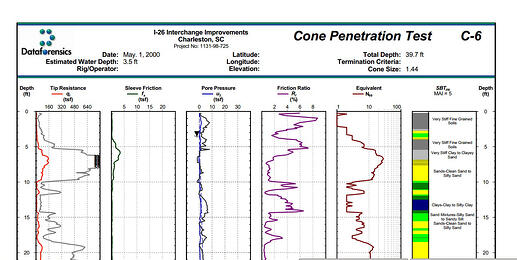If you are considering entering the CPT business from, let’s say, operating a well-drilling business, you’ll want to prepare yourself for a few adjustments. Depending upon the type of business you are used to running or being a part of, you’ll find that the customer interactions may be different. CPT testing is all about gathering data from field tests and quickly turning that into useful information for the site owner, an engineer, construction company, government agency etc.
This blog is an introduction to the basics of CPT reporting. We’ll start with what we’re trying to measure, then we’ll discuss how a CPT system, and in particular the probe, gathers specific types of useful data. Then we’ll, look at some ways that this data is interpreted to make useful information for your customer to make decisions. In real life, you’ll want to use a software application that quickly and efficiently does this interpretation for you. However, Vertek CPT believes in training it’s customer partners from the ground up (so to speak) so that you are comfortable and confident in every conversation you’ll have.
What are we trying to measure?
 CPT is the quickest and most cost-effective way to map out what the soil conditions are under your feet. If you imagine being able to look at the ground ‘from the side’, you’d see layers something like this:
CPT is the quickest and most cost-effective way to map out what the soil conditions are under your feet. If you imagine being able to look at the ground ‘from the side’, you’d see layers something like this:
For people responsible for building highways through hilly territory, or building a heavy structure, it’s important to know what’s underground before they begin planning. This is where CPT comes in. CPT lets you draw a picture of what’s underground for folks who need it.
How Does a CPT Probe Gather Useful Types of Data?
 So let’s start with the Cone, the ‘C’ in CPT. If you look at the picture below, you can imagine the basic scenario of CPT. The primary data that a CPT rig measures, is, ‘how hard do I have to push down to keep a pointed metal rod, of a very particular shape and diameter, moving downward at a very specific speed?
So let’s start with the Cone, the ‘C’ in CPT. If you look at the picture below, you can imagine the basic scenario of CPT. The primary data that a CPT rig measures, is, ‘how hard do I have to push down to keep a pointed metal rod, of a very particular shape and diameter, moving downward at a very specific speed?
So far so good right?
So next imagine this cone being partially hollow and having instrumentation throughout it. This of course would make the rod used to push it deeper into the ground hollow too, so that you can connect cables to the instruments, but that’s the subject of another blog.
How is This Data Interpreted for Your Customers to Make Decisions?
Without getting into definitions here, the essential data that you get from CPT are the Tip Resistance and the Local Friction. These two numbers are used to calculate the Friction Ratio. Ignoring the other measurements that a CPT rig provides for now, such as Pore Pressure, and looking at the image below, you’ll see that you can use the data provided at a given depth to determine what type of soil conditions are at that depth.

You would use a set of standardized charts (provided, with training, by Vertek CPT) to fill in the ‘Interpreted Profile’ information. It’s this information that your customer wants.
Luckily, there is software available from Vertek CPT can do? this interpretation for you. An example of a report that you’d provide from software is shown below.

We want you to understand what is behind these reports so that you are confident that you are providing a quality service to your customers.

Leave A Comment